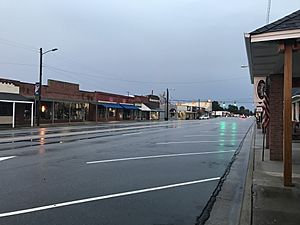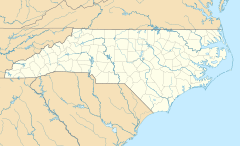St. Pauls, North Carolina facts for kids
Quick facts for kids
St. Pauls, North Carolina
|
|
|---|---|
|
Town
|
|

A view of Broad Street in St. Pauls
|
|
| Nickname(s):
Small Town With a Big Heart
|
|
| Motto(s):
"Window of Economic Development"
|
|
| Country | United States |
| State | North Carolina |
| County | Robeson |
| Incorporated | 1909 |
| Named for | Local church |
| Area | |
| • Total | 1.63 sq mi (4.22 km2) |
| • Land | 1.63 sq mi (4.22 km2) |
| • Water | 0.00 sq mi (0.00 km2) |
| Elevation | 167 ft (51 m) |
| Population
(2020)
|
|
| • Total | 2,045 |
| • Density | 1,256.14/sq mi (485.08/km2) |
| Time zone | UTC-5 (Eastern (EST)) |
| • Summer (DST) | UTC-4 (EDT) |
| ZIP code |
28384
|
| Area codes | 910, 472 |
| FIPS code | 37-58720 |
| GNIS feature ID | 2407393 |
| Website | Town of St. Pauls |
St. Pauls is a town in Robeson County, North Carolina, United States. The population was 2,045 at the 2020 census.
History
The town of St. Pauls was built up around St. Pauls Presbyterian Church, which was built on land donated in 1799 by William Davis. St. Pauls grew slowly from a town of just the church, Davis' home, a post office and a livery stable. The livery was built at the 16-mile post on the Fayetteville to Lumberton stage coach road. Growth began in earnest following the construction of the Robeson Institute, a co-educational school that served the children of northern Robeson County.
The construction of the Virginia and Carolina Southern Railway through St. Pauls helped establish the community as a leading producer of textiles. Three cotton mills were constructed in the early part of the 20th century. The mills experienced periods of success and failure before coming under the control of the Burlington Mills Corporation in 1943. The mills provided significant tax revenue to the town, at one point enabling it to supply free water, sewer, and trash services to residents. Nearly all the mills closed in the 1990s as the textile industry moved from the American South to Latin America and Southeast Asia. The closure of two yarn plants in 2001 led to the loss of over 500 jobs. In the 2000s the job market in the town stagnated, experiencing only minimal growth from the commercial sector developed near Interstate 95. In the 2010s the town secured multiple large corporate investments and relocations.
The Gilmore-Patterson Farm and Kenneth McKinnon House are listed on the National Register of Historic Places.
Geography
According to the United States Census Bureau, the town has a total area of 1.3 square miles (3.4 km2), all land.
Demographics
| Historical population | |||
|---|---|---|---|
| Census | Pop. | %± | |
| 1910 | 419 | — | |
| 1920 | 1,147 | 173.7% | |
| 1930 | 2,080 | 81.3% | |
| 1940 | 1,923 | −7.5% | |
| 1950 | 2,251 | 17.1% | |
| 1960 | 2,249 | −0.1% | |
| 1970 | 2,011 | −10.6% | |
| 1980 | 1,639 | −18.5% | |
| 1990 | 1,992 | 21.5% | |
| 2000 | 2,137 | 7.3% | |
| 2010 | 2,035 | −4.8% | |
| 2020 | 2,045 | 0.5% | |
| U.S. Decennial Census | |||
2020 census
| Race | Num. | Perc. |
|---|---|---|
| White (non-Hispanic) | 865 | 42.3% |
| Black or African American (non-Hispanic) | 346 | 16.92% |
| Native American | 118 | 5.77% |
| Asian | 8 | 0.39% |
| Pacific Islander | 1 | 0.05% |
| Other/Mixed | 77 | 3.77% |
| Hispanic or Latino | 630 | 30.81% |
As of the 2020 United States census, there were 2,045 people, 884 households, and 463 families residing in the town.
2010 census
As of the 2010 United States Census, there were 2,035 people living in the town. The racial makeup of the town was 48.9% White, 18.5% Black, 5.4% Native American, 0.2% Asian, 0.1% Pacific Islander, 0.1% from some other race and 1.7% from two or more races. 25.1% were Hispanic or Latino of any race.
Sports
The Carolina Raging Wolves of the Women's Football Alliance plays at St. Pauls High School, located in the town.
Notable people
- John Beard, news anchor, was born in St. Pauls.
- Judy Clay, soul and gospel singer, was born in St. Pauls.
See also
 In Spanish: St. Pauls para niños
In Spanish: St. Pauls para niños


